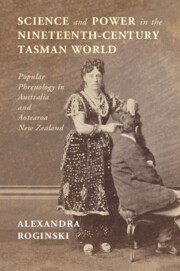 Science and Power in the Nineteenth-Century Tasman World
Science and Power in the Nineteenth-Century Tasman World Published online by Cambridge University Press: 18 May 2023
During the 1870s, popular scientist Professor Bruce grew accustomed to improvisation as he travelled through the Eastern colonies of Australia. While visiting the timber town of Bulahdelah, on the Central Coast of New South Wales, he lectured on phrenology in his Irish brogue within the best space set aside by town residents for the job. In a hut knocked together from slabs of Eucalyptus, the faint glow of six candles in bottles flickered over the faces of thirty or so locals. The audience crowded onto “three boards deposited on three boxes or casks, in the shape of a triangle” to watch the Professor read heads. “I have seen many entertainments in our bush villages and on stations, but never such a gloomy one,” declared a correspondent. “The more so, as I heard that this hut had been not long ago the depositary of a dead body, awaiting an inquest, and some one called it the ‘dead-house’.”1
To save this book to your Kindle, first ensure [email protected] is added to your Approved Personal Document E-mail List under your Personal Document Settings on the Manage Your Content and Devices page of your Amazon account. Then enter the ‘name’ part of your Kindle email address below. Find out more about saving to your Kindle.
Note you can select to save to either the @free.kindle.com or @kindle.com variations. ‘@free.kindle.com’ emails are free but can only be saved to your device when it is connected to wi-fi. ‘@kindle.com’ emails can be delivered even when you are not connected to wi-fi, but note that service fees apply.
Find out more about the Kindle Personal Document Service.
To save content items to your account, please confirm that you agree to abide by our usage policies. If this is the first time you use this feature, you will be asked to authorise Cambridge Core to connect with your account. Find out more about saving content to Dropbox.
To save content items to your account, please confirm that you agree to abide by our usage policies. If this is the first time you use this feature, you will be asked to authorise Cambridge Core to connect with your account. Find out more about saving content to Google Drive.